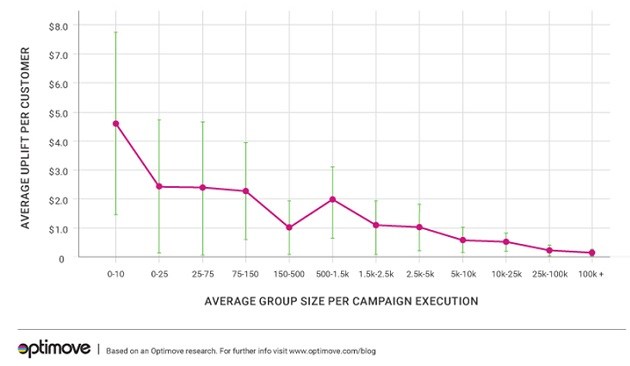For marketers, the quest for branding that matters to consumers has always been about how to achieve deeper relevance. The more relevant a brand is in a customer’s life, the more they’ll begin to look for ways to integrate it into their lifestyle.
Of course, many point to segmentation as the easiest and fastest way to achieve that kind of relevance.
But what if you could go even further?
According to a cross-site study by Optimove, going beyond simple segmentation – down to pure granularity, causes a distinctive and measurable campaign uplift. Optimove measured this by presenting different offers to smaller groups of consumers who had similar attributes. They found by going more and more granular, they were able to generate greater and greater lift within their respective campaigns.
Luck’s Got Nothing to Do With It

LuckyFish, a developer of casino games powered by social networking, created over 100 player personas as part of their relevance campaign
In one such campaign for a set of casino games built on the power of social networking, they were able to segment to over 100 individual player personas. Imagine having that kind of deep detail about your customers or players. As a result, they were able to send the right messages to the right players at the right time, through the customers’ preferred channels.
So what were the results? A 65% increase in conversion rates, a 15% increase in the number of paying players and a 40% increase in the volume of player payments to name a few. As part of the larger study, they looked at this kind of granularity with over 30 million customers across 2,000 campaigns – measuring the uplift of the average campaign in groups of all sizes.
 The smaller the segment, the higher the value per customer
The smaller the segment, the higher the value per customer
The results speak for themselves. The smaller the group, the higher the lift. In this case, the smallest-sized group saw an average increase of $3.2 per customer. When you start sending segmented campaigns to targeted groups of 100,000 customer or more, the monetary uplift drops to a measly $0.1.
Many Small Campaigns Perform Better than One Concentrated One
Another note of the study is that, overall, many small campaigns targeted to a group of customers has a much greater effect on revenues than the all-too-common strategy of throwing an ad at the wall and hoping some of it sticks.
 Hyper-focused segmentation yields even greater results
Hyper-focused segmentation yields even greater results
Now the question then becomes, “why don’t more campaigns do this?” and that’s because there’s some risk involved. As with every strategy, there are exceptions to the rules and things to watch out for – namely, volatility.
Because these groups are so small and hyper-focused, there can be a lot of different outcomes for one message no matter what you’re testing. You can account for much of these differences by chalking it up to a small sample size. The revenues and customer relationship building obtained as a result are far too lucrative to not test granularity in your own campaigns.
How Do You Like Your Coffee?
 What customers say they want, and what they really want, are two completely different things
What customers say they want, and what they really want, are two completely different things
In his famous TED talk on the powers of segmentation, Choice, Happiness and Spaghetti Sauce, Malcolm Gladwell talks about the customer preference of coffee. If you asked most people what kind of coffee they like, they’ll tell you “a dark, rich, hearty roast”. But if you give them that type of coffee, they’d likely rate it as a 60 on a scale from 0-100.
Now, break down that population into their precise coffee preferences and make coffee for them according to their actual tastes – the score would go up to 78/100. Gladwell notes, “the difference between coffee at 60 and coffee at 78 is the difference between coffee that makes you wince and coffee that makes you deliriously happy.”
Is the end result here implying that we shouldn’t trust our customers? Not at all! But it does mean that we shouldn’t hesitate to find out what they really want from our product – and not just rely on what we think they want.
Getting Started with Granular Segmentation
So now that you know the potential of granular segmentation, how do you do it?
The first step is to look at your existing campaign channels – are you running PPC ads? Doing social media marketing? Blog posts? Landing pages? All of the above? Good. Make a note of where your best traffic is coming from right now — and even if it’s all of those places, that’s perfectly fine.
Next, imagine your prospect has just saw your campaign ad. Map out all the possible ways your prospects can interact with it. For instance, they could:
- View
- Click
- Share
- Call
- Add to Favorites/Bookmarks
- Link
- Download
- Comment
- Buy
- Rate
- Review
Now, sort these according to the type of campaign channel. For example, people using social media are more likely to share, view and click, while people on a landing page are more likely to download, click, add to favorites, or even call for more information.
Once you’re sorted, it’s time to organize these labels so that your analytics (and the people behind them) can make sense of it all. UTM identifiers are great for this purpose. Here’s how to set those up in Kissmetrics. You can use event tracking to see who clicked on buttons on your landing pages or social media campaigns, for instance. Some of these steps, like calling or adding to bookmarks, need to be handled manually (some stats programs will tell you if someone accessed your page via a bookmark), but the goal here is to see who’s interacting with your pages and how.
If you want to segment your ad campaign, you can build custom audiences in Google Adwords in a few simple steps, including segmenting them by conversions, transactions, time of day, device used and more. Although these are all technical “granularizations” and the ones I mentioned above are more qualitative, having this kind of precision in defining and better understanding your audience is vital to giving them what they truly want, and making them deliriously happy.
Getting to Deliriously Happy
Our goal as marketers is to get customers on the deliriously happy end of the spectrum. Granularity may seem like an awful lot of segmentation just to reach a handful of people. But being able to chunk the process down again and again means you’re reaching those people with the kind of relevance that broader campaigns simply can’t match – and that’s where you’ll come out ahead. If you’ve ever hoped a customer might think “it’s like they KNOW me!” – granular segmentation is your answer.
Remember that by segmenting campaigns with this kind of laser-focused attention, you’re not only increasing conversions but building relationships with your customers using the kind of personalization they crave. It’s a win-win for everyone.
Now It’s Your Turn
Do you micro-segment your customers and your offers to them? What have your results been like so far? Do you find that customers are more receptive to offers, or is it just too much effort for lackluster and volatile results? We want to know what you think, so share your thoughts in the comments below!
About the Author: Sherice Jacob helps business owners improve website design and increase conversion rates through compelling copywriting, user-friendly design and smart analytics analysis. Learn more at iElectrify.com and download your free web copy tune-up and conversion checklist today!
from The Kissmetrics Marketing Blog https://blog.kissmetrics.com/segmentation-relevance/
No comments:
Post a Comment